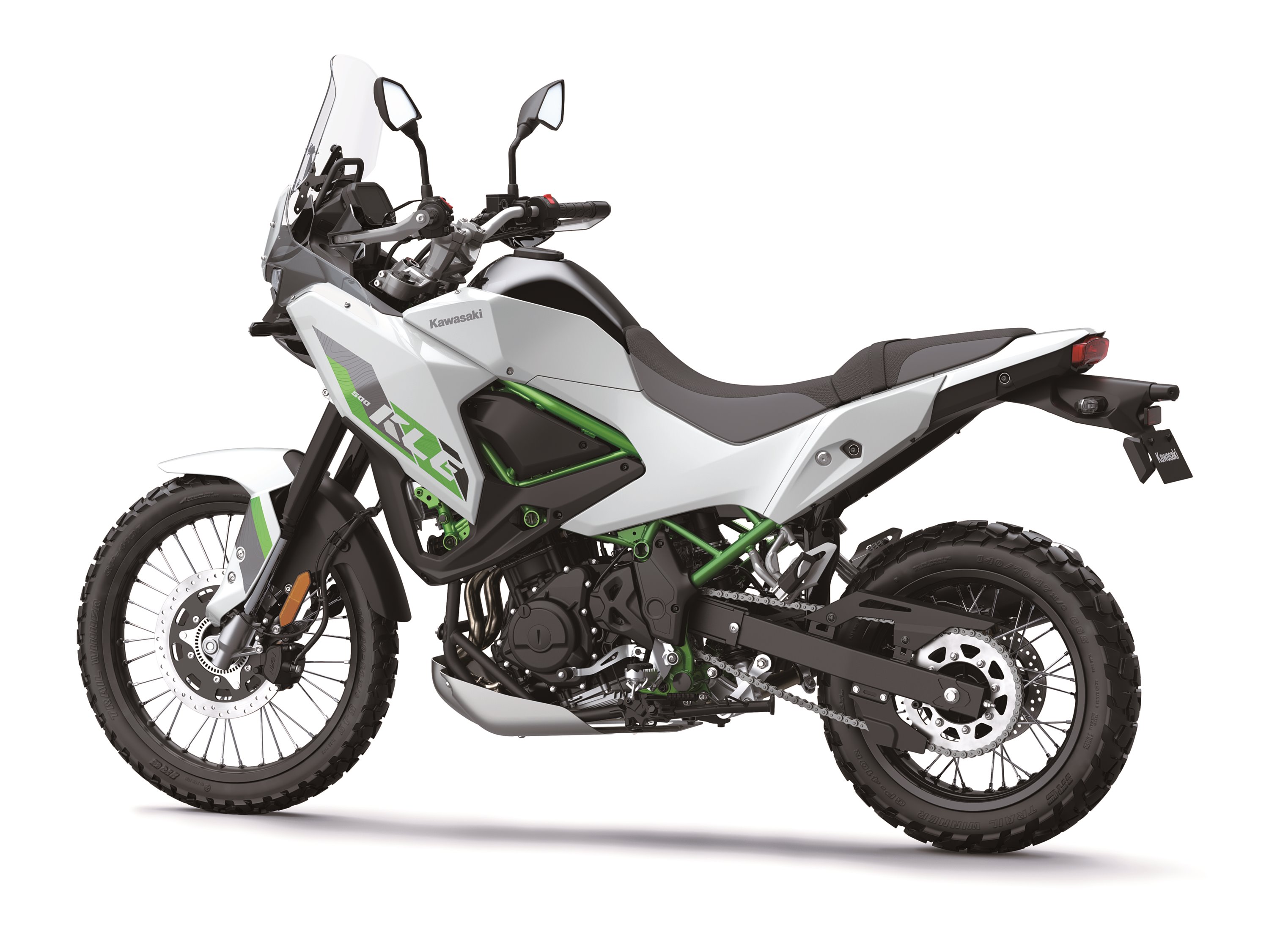https://media.notthebee.com/articles/690361ec131a7690361ec131a8.jpg
30 minutes.
Not the Bee
Just another WordPress site
https://media.notthebee.com/articles/690361ec131a7690361ec131a8.jpg
30 minutes.
Not the Bee
https://s3.amazonaws.com/images.gearjunkie.com/uploads/2025/10/26KLE500D_242WT2ARFB00D_A.high_-600×400.jpeg

The 2026 Kawasaki KLE500 is a new middleweight off-road-focused adventure bike that slots between the Versys-X 300 and KLR650 in Kawasaki’s lineup. This model was available in other markets around the globe from 1991 to 2007, competing against such legendary nameplates as the Transalp and Ténéré. Those names have also come back onto the market in recent years, and are also available on the U.S. market.

The market for lighter and smaller adventure motorcycles has been hot in recent years, and Kawasaki wants even more skin in the game with its most off-road–focused model in the segment yet. Let’s dive into what the 2026 Kawasaki KLE500 is all about.

A completely new, purpose-built steel trellis-style frame is the backbone of this machine. It uses the engine as a stressed member to keep the weight down. Kawasaki says the KLE500 chassis only weighs 41.8 pounds.
“Rather than adapting motocross geometry, Kawasaki designed the frame for versatility and comfort across diverse conditions — from daily commuting to forest trails,” said the company in its press release.

This lightweight chassis is paired with a 21-inch front and 17-inch rear wire wheel. Suspension is handled by a 43mm cartridge-type inverted KYB fork, with 8.3 inches of travel, and a basic square-section rear swingarm with Kawasaki’s “new Uni-Trak suspension,” offering 7.9 inches of wheel travel. All in, this chassis, wheel, and suspension setup offers up 6.8 inches of ground clearance.

Something that is not bespoke to the 2026 Kawaskai KLE500 is the 451cc parallel twin engine. This same engine can be found in Kawasaki’s Eliminator and Ninja 500.
While we don’t yet know what the performance numbers of the new KLE500 are, this same motor can put out up to 51 horsepower in other applications. This adventure bike will likely be detuned a bit from that, however.

With a 4.2-gallon tank, the KLE500 should offer up impressive adventure range as well.
Stopping this machine are single 300mm front and 230mm rear brake disc with twin-piston calipers. ABS is standard, and most importantly selectable through a switch on the left handlebar.

The windshield is a three-way adjustable height unit, flanked by transparent panels on both sides of the headlight. The setup should offer great visibility on the trail while also providing great wind protection on the highway.
Behind that windshield is an LCD instrument panel with smartphone connectivity, which provides call and email notifications on the dash. Kawasaki’s Rideology app also provides bike and ride data logging on your phone.

The seat on the KLE500 is long and pretty skinny, which should offer lots of room to move around and work well while standing off-road. The seat is also only 33.8 inches off the ground, which makes the bike great for a wide range of rider leg lengths.

The seat itself also has some unqiue hollow channels in it, which are designed for more cushion and longer ride comfort.

If you want all the bells and whistles, step up to the SE model. It offers a 4.3-inch color TFT dash, a 4.1-inch taller windscreen, LED turn signals, a larger skid plate, and metal-reinforced hand guards.

Pricing for the base model 2026 Kawasaki KLE500 starts at $6,599. Add $900 ($7,499) to step up to the SE model. This new adventure bike is hitting North American dealers now.
GearJunkie
https://www.buckeyefirearms.org/sites/buckeyefirearms.org/files/styles/slideshow/public/field/image/Cincinnati-Riverboat.jpg?itok=ehMcd5jk

The city of Cincinnati set up a riverboat festival, called River Roots Festival, at Public Landing, Yeatman’s Cove, and Newpart Festival Park. I went to their website and looked at their FAQ list of questions, and it had a section listing prohibited items. Among them were weapons of any type.
I had been to Oktoberfest Zinzinnati in the same area a year ago, and there were no "gun-free zone" signs posted or searches to enter the park.
As I thought about Ohio law and gun-free zones in public places, the list of prohibitions is very specific, and none of them seemed to apply to this festival’s public parks. It was not in government buildings or a school zone or on private land. I also remembered that the Champaign County Fairgrounds had tried to ban firearms, and Ohio Attorney General Dave Yost issued an opinion that a government jurisdiction, such as a city, county, or their groups, could not impose any gun laws — only the state legislature could.
I called the Ohio Attorney General’s Office and asked how I could get the city to reverse its gun-free-zone designation at the festival. The representative told me only the county or city prosecutors could do anything. She said the prosecutors office of the city or county would have to contact the Ohio Attorney General’s Office and request an opinion on the facts of the situation. Once that opinion is issued, the prosecutor could apply to the courts for an injunction stopping the local government from violating the law by banning the guns or making new gun laws.
I researched the Ohio Revised Code regarding gun-free zones, specifically Section 2923.126, duties of licensed individuals. I also looked at ORC 9.68, which is about preempting local governments from establishing any gun laws. Once I had all my facts, I submitted a clear and concise letter to both the Hamilton County Prosecutor’s Office and the Cincinnati Solicitor’s Office, explaining that I wanted to stop the festival or city from banning guns at the festival because they were breaking the law by doing so. I did not want to depend on the people with whom I had spoken to relay my request and reasoning from memory. SEE MY LETTERS BELOW.
I visited the Hamilton County Prosecutors Office, where the receptionist had no idea how to help me. It just so happened that a detective who was on the prosecutors staff walked by, and she asked him to talk to me. The detective listened while I explained that the city was trying to enforce an unlawful gun-free zone at the festival’s public parks and that I was told by the Ohio Attorney General’s Office that I should contact the county prosecutor to fight it. He had no clue on how to help or to whom to refer to me.
The detective took my letter and told me he would try and find the right person to help me.
I did not have a lot of confidence that anything would be done at the county level. So I emailed the festival organizers and explained that among the places that could ban guns, none of them applied to their festival. I informed them that banning weapons at the event was illegal and could open the city and the organizers’ nonprofit to litigation. I suggested they review the matter with their legal staff and remove the firearms prohibition from their website.
The following day, I went to Cincinnati City Hall and to the City Solicitor’s Office, which handles the city’s legal matters. Most of the staff at the solicitor’s office had left for the day, but I handed my letter to the receptionist to relay to the solicitor, again explaining my complaint and contact information. The receptionist did suggest talking to someone on City Council’s staff and referred me to the staff of a council member who was in charge of festivals. That staffer listened to me but did not seem to know what to do with my complaint. I handed her one of my letters, and she called someone above her. She told me she would get back to me by phone. I figured it was a lost cause, but I at least tried to fight for my Second Amendment rights.
To my amazement, she called me back within 15 minutes and told me she had talked to the festival organizers and that the weapons prohibition would be removed from the website that evening. I checked that same night, and it was indeed changed from all weapons prohibited to a caution that the boat operators were private companies who are permitted to ban weapons from their privately owned boats.
Perhaps the festival organizers had merely used a generic website outline and did not know the firearm prohibition was illegal. Then just maybe, once festival organizers were informed of the law and their legal staff investigated the situation, they rightly removed the prohibition. It’s much less likely that city officials would have changed their minds in such a short time.
If you find yourself in a position like this and want to challenge the legality, first research how the law applies to your situation. I suggest putting it in writing in the form of a letter, with all the facts and legal references, along with your contact info.
I have discovered that it is better to visit offices in the morning to avoid the risk of staffers leaving early. Write down all the names of those you talk to or give your letter. Emailing or mailing a letter probably won’t get enough attention to convince someone to help you. It is more difficult for them to ignore you if you are standing in front of them while sharing your complaint. Dress nicely, remain polite, and thank them for listening. Don’t make demands or threats.
I figured I had no chance of winning, but I won, not just for myself but also for all gun owners. You can’t win if you don’t try. All it takes is a little time and effort to defend your rights, and you could win, too.
Dear Sir or Ma’am
I would like to bring to your attention that the website for the America’s River Root Festival (www.americasriverroots.com/faq) taking place in Partnership with the City of Cincinnati has stated in the FAQ section about prohibited items. “Weapons including, but not limited to: Knives, explosives, stun guns, handcuffs, brass knuckles, sticks, clubs, batons, martial arts instruments,
pepper spray, tear gas, etc. Guests found in possession of such items will be asked to remove the items from park property or dispose of them.” The Festival is to take place on the City property of the Public Landing and Yeatman’s Cove Oct 8-12th.
Neither the Festival or the City of Cincinnati have the legal authority to create “Gun Free Zones” outside of the State Law Ohio Revised Code Section 2923.126 | Duties of licensed individual.
The Champaign County Fair case clearly demonstrated that local authorities or cities do not have the legal authority to establish “Gun Free Zones” https://buckeyereporter.com/stories/674322073-champaign-county-drops-firearms-ban-after-challenge-from-the-buckeye-institute
While I am sure this was just an oversight I would request you inform the America’s River Roots Festival organizers that banning weapons especially by Legal Concealed Handgun License Holders from an open air festival on public property is not legal. I expect to see a change in the FAQ section Prohibited Items to remove Weapons from their list. https://www.americasriverroots.com/faq
Thank you for your attention to this matter.
Sincerely
Keith Schuch
Dear Sir or Maam,
I would like to point out a violation of Ohio Revised Code 9.68 Preemption of Firearm Regulations in Ohio. The City of Cincinnati in partnership with America’s River Roots Festival ( a Non Profit group) is having a Riverboat Festival on the Public landing ( City owned property). On the www.americasriverroots.com frequently asked questions page it Prohibits Firearms or weapons at the festival. The prohibition is an illegal act under ORC 9.68. The event is on City Land so it is not covered under private businesses being able to ban firearms from their property. It is an open air venue with some tents and vendor booths but no buildings. The event will have an alcohol permit but people with Concealed Handgun Licence Holders cannot be banned if they don’t consume alcohol. As long as a CHL holder does not enter tents,buildings or boats or consume alcohol they cannot be banned from having their firearm concealed on their person in the open air parts of the festival. I would request that the Hamilton County Prosecutor’s Office inform the City of Cincinnati officials that the banning of firearms at a public outdoor event is a violation of Ohio Revised Code 9.68 Preemption of Firearms Regulations and to force them to lift the firearms ban at the festival. This case is similar to a County Fairgrounds banning firearms at a county fair. The Ohio Attorney General has issued an opinion stating that firearms cannot be banned by a political subdivision (City of Cincinnati). I request the Hamilton County Prosecutors office assist me in stopping this violation of my Second Amendment Rights.
Thank you for your help in this matter.
Sincerely,
Keith Schuch
Buckeye Firearms Association
https://static0.makeuseofimages.com/wordpress/wp-content/uploads/wm/2025/10/laptop-screen-showing-chrome-s-ad-privacy-settings-page-with-the-site-suggested-ads-option-visible-1.jpg
I thought Chrome’s privacy settings were already tight enough. I cleared history often, blocked cookies, and turned off every tracking option I could find. But the ads I saw still seemed to know exactly what I was doing. They lined up too closely with my recent searches, as if Chrome itself was quietly helping websites follow me around. So I looked more closely at Chrome’s menus and found a hidden panel I had completely overlooked.
Ads were not the real problem. What unsettled me was how precisely they mirrored what I had been doing online. I cleared my browsing history on a schedule, turned off activity sync I did not need, reviewed site permissions, and kept a tight leash on cookies. I also blocked third-party cookies and regularly cleared site data for places I no longer visit.
Over time, those steps became routine, and I felt confident that the major gaps were closed. When I still saw a few targeted banners, I assumed that was just how the web works. But that changed when ads started matching things I had only looked at once. I would check the price of something, and the same product would appear the next day.
At that point, I realized that the usual privacy tools were not covering everything. Even with strict cookie and sync settings, my browsing behavior still shaped what appeared later. It felt as if there was another layer quietly influencing what I saw, one that the regular controls were not addressing.
Digging through the menus took me to Privacy and security, then Ads privacy, and finally to Site-suggested ads. The option lives in that sub-menu, and my browser does not call it out during setup. Even if you care about privacy, it is easy to skip because the name does not clearly suggest tracking.
Opening the page makes its purpose clear. The description says that websites and their advertising partners can use your activity, such as how you spend time on the sites you visit, to personalize ads for you. Your activity is one of many signals a site can use to suggest ads, and when this setting is turned off, you still see ads, but they may be less personalized. This setting sits under Ad privacy and works independently of cookies and history, so changing those settings alone will not turn it off.
On the same page, Chrome lists sites that have used your activity. You can block any of them from suggesting ads, and Chrome automatically removes entries that are older than 30 days. Below is a blocked sites section that stays empty until you add one yourself. All of these options sit on one level under the usual privacy menu, with nothing to call them out, making them easy to overlook.
After I turned off the Site-suggested ads, I still saw ads, but they stopped matching what I had just searched for or viewed. Over the next few days, the repeat banners I was used to seeing showed up less often, and more ads looked general rather than tied to my latest activity. The change was subtle but clear. Fewer ads followed me between websites, and browsing no longer felt like my recent clicks were shaping every page. The web looked the same, yet it felt less aware of me.
What I noticed in my browsing also showed up in the settings. A small note there confirmed what I was seeing. The Sites section shows sites that have used your activity, and notes that entries expire after thirty days. With the setting off, I saw no new sites appear there. That matches the notice on the page that turning it off does not remove ads, but it can make them less personalized.
While the difference was clear, I can also see why some people prefer keeping personalization on. Relevant ads can make shopping easier and sometimes surface deals you would have missed. They can make browsing feel more tailored. However, convenience does not always justify the amount of information shared in the background. I would rather keep this off and add personalization only where I choose, rather than letting recent browsing dictate what I see by default.
Chrome gives you more control than it seems if you know where to look. Many of its privacy tools remain buried in menus most people never open. If you care about privacy, take a few minutes to explore these settings. Review every toggle under Privacy and security, especially inside Ad privacy.
Clear your browsing data regularly, disable third-party cookies, and review the site permissions you have granted over time. You do not have to block every ad or break every site to stay private. What matters is knowing which toggles make the most impact.
MakeUseOf
https://static0.makeuseofimages.com/wordpress/wp-content/uploads/wm/2025/10/using-keep-on-amazon-website.png
I used to fall for flashy discounts and so-called limited-time deals until I found Keepa. It’s a handy tool that collects and analyzes price data and sales trends for products sold on Amazon. Now, I can spot real deals on Amazon instead of just getting impressed by clever marketing tricks. Keepa shows me the full price history of any product, so I can verify if the discount is actually legit. It has saved me from overpaying more times than I can count.
I’ve been using Keepa since 2019, and it has helped to snag my favorite products at the best prices. Before using Keepa, I often bought products thinking they were good deals (those 70% discounts and limited-time deals, you know). However, some of my friends would tell me they bought the same product at a much lower price a few weeks ago. That’s when I discovered Keepa, and since then, it has become my Amazon shopping sidekick. It is one of the best price tracking sites that keeps an eye on price changes and tells me the best time to grab a product.
Now, when I want to buy a product on Amazon, whether it’s smartphones, tech gifts, accessories, or even exotic groceries, I rely on the Keepa chart to verify whether it’sa good deal. For instance, I was eyeing a hair straightener on Amazon, and it seemed to be at its lowest price. However, Keepa showed me the price was $40 lower just two weeks ago. I waited for some time, and the price dropped again. The best thing about using Keepa is that I don’t have to manually check prices. I just have to set a price alert, and Keepa notifies me when the price hits my target. This way, Keepa makes sure I’m never overpaying for my Amazon purchases.
Keepa is available as a website and a dedicated app for iOS and Android smartphones. Just download the app on your smartphone, and choose settings like language and preferred Amazon locale (.com, .co.uk, etc.). Then, log in or sign up for a Keepa account. Once you’ve done this, tap the Amazon tab from the bottom, sign in with your Amazon account, and start exploring the products.
Keepa is also available as a free extension for Google Chrome, Mozilla Firefox, Safari, Microsoft Edge, and other major browsers. Here’s how to add it as an extension on your preferred browser:
Once you’ve added the Keepa browser extension, it will automatically show up when you visit a product page on Amazon. Right below the product information, Keepa will show you a price history graph.
Keepa is super easy to use. Once I’ve installed the extension, Keepa appears automatically on the product page. It shows me the full price history, so I don’t have to guess whether the product is available at its best price. If the price is higher than usual, I know I have to wait. Otherwise, I’ll quickly hit the Buy Now button.
Here’s how you can check Amazon’s price history with Keepa:
That’s how I use Keepa to double-check deals and discounts on Amazon.
Beyond checking the price history, I also use Keepa to track prices for the products I’ve been eyeing. For instance, I was planning to get Bose speakers available on Amazon for $299, but now they’re at $399. Rather than constantly checking the price manually, I’ll create a Keepa tracker to get an alert when the price drops to $299 or below.
You can also do the same for your products. First and foremost, you have to create an account on Keepa. Once you’ve done that, you can create trackers for any product available on Amazon. Here’s how to do it:
Now, Keepa will start tracking the price and alert you as soon as it hits the target. You can find and manage all your trackers in Keepa’s Tracking overview page.
Keepa has become my ultimate companion for Amazon shopping. I can spot genuine deals and avoid falling for tempting discounts and impulse buys. I don’t remember the last time I shopped on Amazon without tracking the price with Keepa. If you’re also an Amazon shopper like me, Keepa is an absolute must-have.
MakeUseOf
https://media.notthebee.com/articles/68f256f10ead868f256f10ead9.jpg
You’ll always remember your wedding day. And that goes doubly if the vice president just happens to roll up.
Not the Bee
https://cdn.arstechnica.net/wp-content/uploads/2020/08/GettyImages-462699436-1024×648.jpg
Backblaze is a backup and cloud storage company that has been tracking the annualized failure rates (AFRs) of the hard drives in its datacenter since 2013. As you can imagine, that’s netted the firm a lot of data. And that data has led the company to conclude that HDDs “are lasting longer” and showing fewer errors.
That conclusion came from a blog post this week by Stephanie Doyle, Backblaze’s writer and blog operations specialist, and Pat Patterson, Backblaze’s chief technical evangelist. The authors compared the AFRs for the approximately 317,230 drives in Backblaze’s datacenter to the AFRs the company recorded when examining the 21,195 drives it had in 2013 and 206,928 drives in 2021. Doyle and Patterson said they identified “a pretty solid deviation in both age of drive failure and the high point of AFR from the last two times we’ve run the analyses.”
As Doyle and Patterson wrote, the tested drives’ high failure percentage peaks this year were 4.25 percent at 10 years and 3 months, compared to 13.73 percent at about 3 years and 3 months in 2013 and 14.24 percent at 7 years and 9 months in 2021.
“Not only is that a significant improvement in drive longevity, it’s also the first time we’ve seen the peak drive failure rate at the hairy end of the drive curve. And, it’s about a third of each of the other failure peaks,” Doyle and Patterson wrote.
You can check out Paterson and Doyle’s August blog post for more information about the drives they analyzed this year. The drives were from HGST, Seagate, Toshiba, and WDC, and they had an average age of 3.7 months to 103.9 months (about 8.7 years). The drives ranged from 4TB to 24TB. In 2021, Backblaze’s sample had drives from the same vendors, and the drives tested for each model had an average age of 3.57 to 80.85 months (about 6.7 years). The drives ranged from 4TB to 16TB.
As Backblaze has done in the past, Doyle and Paterson compared the behaviors of Backblaze’s datacenter HDDs with the bathtub curve, an engineering principle that says component failure rates tend to follow a U-shape over time, with more failures occurring early in life before the rate drops, settles, and then picks up again as the component ages.
Ars Technica – All content
Laravel News Links
Laravel News Links
https://static0.makeuseofimages.com/wordpress/wp-content/uploads/wm/2025/10/aerial-view-of-whipsnade-zoo-in-the-uk-with-the-lion-point-marked-on-google-maps.jpg
Occasionally, I fall down a Google Maps rabbit hole. It always starts innocently enough—checking directions, maybe zooming in on a landmark—and somehow ends with me wandering across deserts, oceans, and random parking lots on the other side of the world.
Sometimes I’m up in the clouds using satellite view, other times I’m dropped right there on the ground using Google Maps’ Street View, peering around corners like a tourist. And just when I think I’ve seen it all, Google Maps throws me something so strange I can’t look away. I’ve seen a number of odd discoveries that are still hiding in plain sight.
Cut into the rolling chalk hills of Oxfordshire, the Uffington White Horse is a prehistoric hill figure dating to the late Bronze Age or early Iron Age, making it roughly 3,000 years old. It measures about 110 meters from tail to ear and was made by carving deep trenches into the hillside and packing them with crushed white chalk, which is why the shape reads so clearly from above against the green landscape.
Archaeologists still debate why someone made it. Suggested ideas include a territorial or tribal emblem, a ritual or religious symbol, or an image tied to seasonal or celestial markers, but no single explanation has convincing proof. What is certain is that generations of people have kept the figure visible through a practice called scouring, and today the National Trust and local volunteers continue that maintenance. The Horse still pops up on drone and satellite images as a bright, enigmatic mark on the landscape, proof that some prehistoric gestures survive into the age of mapping and pixels.
Hidden deep in Japan’s Iya Valley is Nagoro, a place where people are overwhelmingly outnumbered by their replacements. In 2003, Tsukimi Ayano returned to her native village after retiring and was surprised to find it had become so lifeless. She began creating life-sized dolls to represent the neighbors she’d lost, including farmers, people taking smoke breaks, figures waiting at bus stops, and people tending gardens.
She has since made more than 400 dolls, including replacements, with about 350 currently displayed in the village. One of the most touching spots is the abandoned school, where Ayano has filled the desks with dolls of children. Seen on Google Maps’ historical street view function, many of Ayano’s dolls are visible and appear hauntingly lifelike.
A few hours south of Uffington sits another chalk figure, and this one doesn’t exactly blend in. Etched across a Dorset hillside, the Cerne Abbas Giant stands about 55 meters tall, showing off a bald, naked man with a very noticeable erection and a hefty club in hand. You can spot it clearly on Google Maps, and even from a distance, it’s one of those things that makes you pause and think, someone actually carved that into a hill. Today, the National Trust looks after it, and it still holds the title of Britain’s largest chalk hill figure.
For a long time, nobody really knew where the giant came from. Some thought it dated back to prehistoric times, but modern testing told a different story. Using a method called optically stimulated luminescence, researchers discovered it couldn’t have been created before the year 700. That means it probably appeared sometime between 700 and 1100 AD. One theory even suggests the figure might represent an Anglo-Saxon god named Heil or Helith.
Along Highway 5, just outside Suomussalmi in the Finnish countryside, there’s a field that’ll stop you mid-scroll on Street View. Out of nowhere, you’ll see an eerie crowd of several hundred life-sized figures frozen in place, like a rural version of a zombie apocalypse. The installation, created by artist Reijo Kela in 1988 and moved to its current spot in 1994, consists of scarecrow-like forms with peat heads, straw hair, and simple wooden frames, dressed in bright, mismatched clothes. Locals even change their outfits twice a year, so the whole scene shifts with the seasons.
Many believe the figures were meant to honor the people who died nearby during the brutal Winter War between Finland and the Soviet Union in 1939 and 1940.
In Valencia’s Turia Gardens, there’s a massive figure of Gulliver stretched out on the ground, about seventy meters long and nine meters high. From above, it looks like some strange, oversized body frozen mid-scene, but zoom in on Google Maps, and you’ll realize it’s actually one of Spain’s most adored playgrounds. The design captures the moment when Gulliver was tied down by the tiny Lilliputians, and here, everyone who visits gets to play the part of one.
The giant’s body is a maze of stairs, slides, ramps, and ropes. His clothes and hair have been cleverly turned into different play areas, so kids can scramble up his sleeve, slide down his arm, or disappear into the folds of his coat.
If you zoom in on a wooded hillside in Oregon’s wine country, you might think you’ve stumbled upon a plane crash. But look closer, and you’ll see the aircraft is perfectly intact, sitting right where someone meant it to be. Hidden among the trees on a quiet slope is a full-sized Boeing 727, bought by Bruce Campbell for around $100,000. Back in 1999, this former engineer and pilot had the entire jet shipped all the way from Greece to Oregon—and turned it into his home.
Campbell says he has no plans to ever live in a normal house again, so this retired jetliner has become a permanent resident of the forest, blending aviation with a touch of eccentric genius.
If you drop into Street View and wander through the canals of Xochimilco, just south of Mexico City, you’ll eventually come across something straight out of a horror movie. All around you, hundreds of dolls hang from trees—some missing heads, others missing limbs, all of them staring blankly into the air.
The story goes that Don Julian Santana Barrera, who once lived on the island, began hanging the dolls to calm the spirit of a young girl who had drowned nearby. Over time, he claimed to feel her presence and started collecting more dolls to keep her spirit at peace.
He didn’t care what shape they were in, whether they were broken, dirty, or decapitated; it didn’t matter. He hung every single one, and together they’ve become one of the most unsettling, yet oddly fascinating, tourist attractions in the world.
In Argentina’s Córdoba province, there’s a massive guitar-shaped forest carved into the pampas, stretching almost a kilometer across. You can spot it easily on satellite view, a green instrument laid out in perfect detail with over 7,000 cypress and blue eucalyptus trees. There’s even a star-shaped sound hole in the middle.
The idea came from farmer Pedro Martín Ureta’s late wife, Graciela, who once saw a farm from the air and dreamed of creating something beautiful like that on their own land. After she passed away, Ureta and his children spent years planting and shaping this living tribute to her. Now, their guitar of trees stands as a quiet, breathtaking symbol of love that’s visible from space.
Just outside Whipsnade village in Bedfordshire, a huge white lion sprawls across the chalky slope of Dunstable Downs. It’s so large you can spot it clearly from satellite view on Google Maps, even on your Windows PC, standing out like a bold signature against the green landscape. The Zoological Society of London created the lion near Whipsnade Zoo—the biggest in the UK—to help warn pilots not to fly too low and disturb the animals.
For nearly a century, the Whipsnade White Lion has watched over the downs, becoming a proud local symbol. From above, its bright white outline pops against the hillside, making it one of England’s most recognizable and enduring landmarks.
The strangest thing about these places isn’t how bizarre they look, but the fact that they’re still here, still cared for, still loved by someone. Google Maps has become an accidental gallery for all of it, quietly proving that somewhere out there—in a field, a forest, or on a hillside—someone’s imagination left a mark strong enough to outlive them.
MakeUseOf